Oysterponds Historical Society holds one of the most significant collections representing a single location on Long Island. The collections are comprised of more than 60,000 items dating from the earliest days of the North Fork's settlement by the people of the Algonquin Nation all the way to to the present, nearly all collected from the East End hamlets of Orient and East Marion.
Major strengths of OHS’s collections are its manuscripts and documents; photographs; textiles, including costume, quilts, and coverlets; logbooks, journals, and correspondence re whaling voyages; 18th and 19th century furniture and ceramics; early-19th century portraits; late-19th century ship portraits; photographs, paintings, and prints by William Steeple Davis (1884-1961); and farming and fishing tools and equipment.
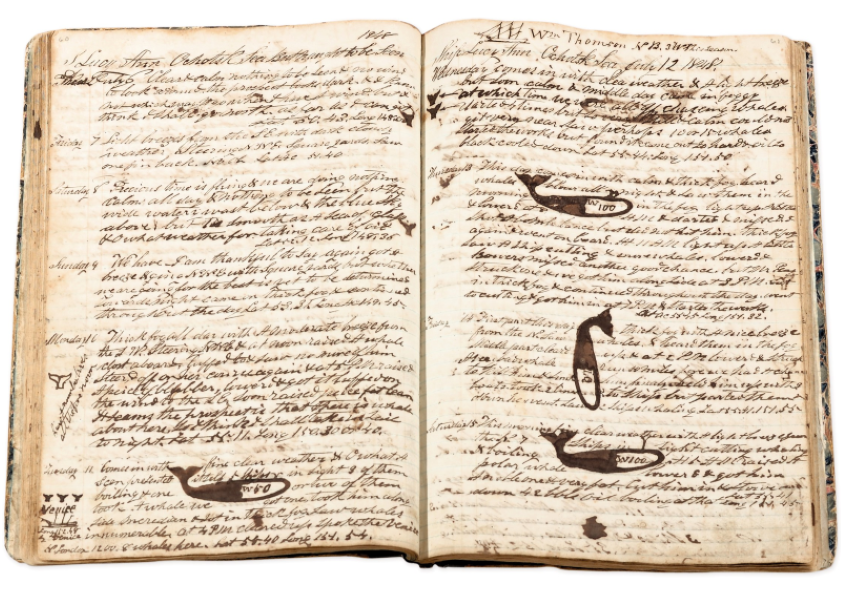
Logbook of the Ship Lucy Ann Bound on a Whaling Voyage
August 31, 1847, to July 7, 1849.
12 ½ x 15 ¾ inches.
Captain Edwin P. Brown, Orient’s only whaling captain, was born in Oysterponds in 1813, one of ten children. The voyage on the Lucy Ann recorded in this logbook lasted just under two years. Captain Brown was accompanied by his wife, and her account of the voyage makes for one of the most interesting diaries in the OHS collection. At this point, he had left his wife in Honolulu to await the birth of their child and was seeking whales in the North Pacific. The four whale stamps with blanks record the number of barrels of whale oil taken from each whale. The tails of diving whales indicate whales pursued but lost. The logbook was a gift of Captain Brown’s granddaughter Mildred Prince and great-granddaughter Barbara Hughes.
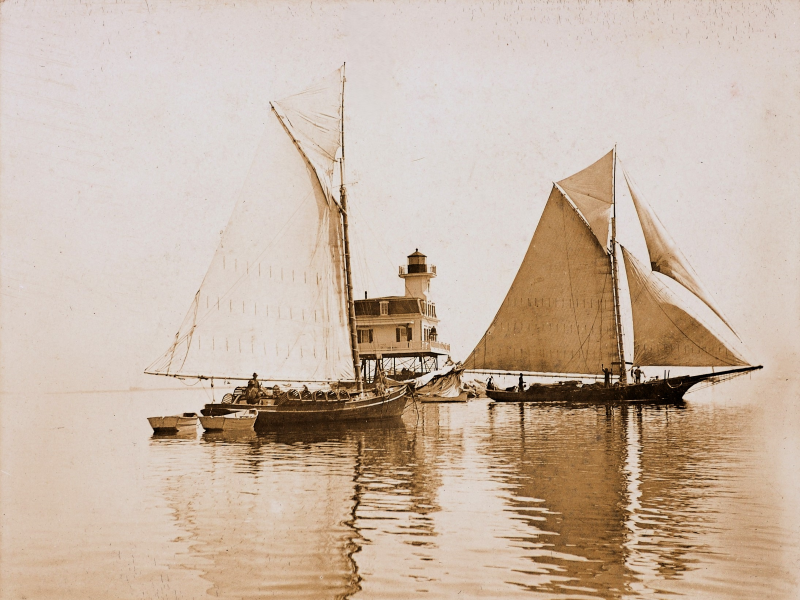
William Steeple Davis. Photograph, undated.
3 ¾ x 4 ¾ inches.
William Steeple Davis (1884-1961), a painter, illustrator, printmaker, and photographer, spent most of his life in Orient. His legacy of thousands of glass-plate negatives and vintage photographs is remarkable and forms one of the most significant collections within the holdings of the OHS. These photographs provide an important record of the physical appearance of Orient and East Marion over many decades in the first half of the twentieth century. Bug Light is a charming mansard-roofed lighthouse at the tip of Long Beach in Orient harbor. It was destroyed by fire in 1963 and rebuilt some years later. The sloop shown on the right is the Black Eagle, a well-known Orient fishing vessel owned by several local families. This photograph was the gift of the William Steeple Davis estate.
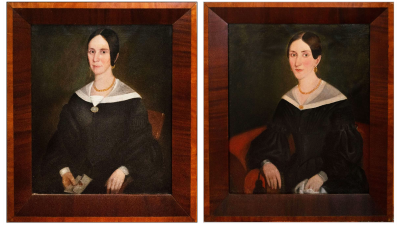
Portraits of Elizabeth Brown Dyer Tuthill (right) & Laura L. Dyer Holmes (left), 1842 by William Garl Brown, Jr. Oil on panel.
In the recent past OHS was extremely fortunate to have been given not one but two striking 19th century oil portraits. Oysterponds sisters Elizabeth Brown Dyer Tuthill (right) and Laura L. Dyer Holmes (left) were both painted in 1842 by 19-year-old William Garl Brown, Jr., in a manner typical for the period. Brown, Jr. went on to become an acclaimed, nationally-known portrait artist whose later works included noteworthy depictions of prominent Southerners, including statesmen and military officers. These two works, in exceptional condition and in their original, matching frames, remarkably remained in two branches of the family up until they were donated to OHS. Ruth Tuthill and her brother Lyle Tuthill donated the portrait of Elizabeth Brown Dyer Tuthill and Sally Leety-Stevens donated the portrait of Laura L. Dyer Holmes
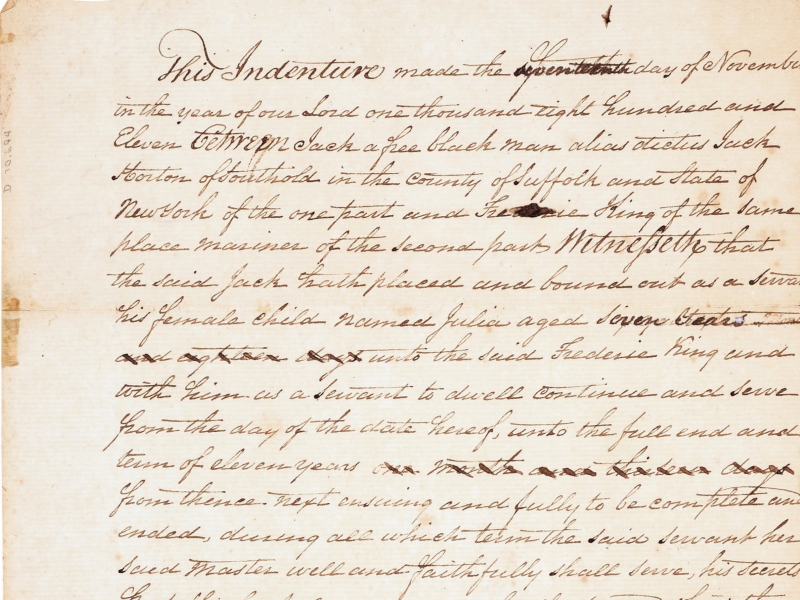
Indenture Between Jack, “a free black man” and Frederick King (detail)
November 17, 1811, 12 ¾ x 8 inches.
This document concerns an agreement between Jack, “a free black man,” and Frederick King, “mariner.” They agree herein that Jack’s young daughter, Julia, shall be “placed and bound out as a Servant” for eleven years – until she reaches the age of eighteen. A standard form used for apprentices was clearly adapted for this particular circumstance. Julia was expected to keep Captain King’s secrets and “not embezzle, waste or lend” his goods. For his part, King agreed to provide Julia with “meat drink washing, lodging and apparel both woolen and linnen” and to send her to school at least one month a year. At the end of her term she would receive “a good English bible and a new suit of cloths.”
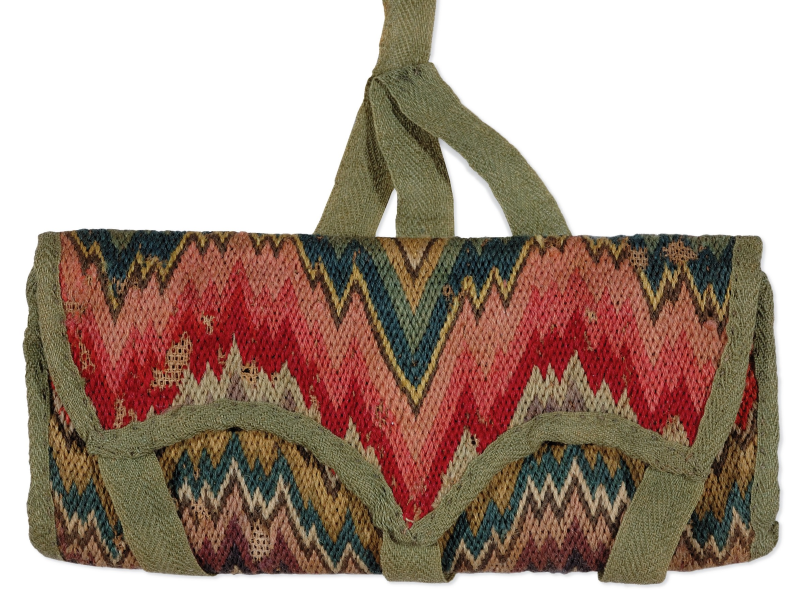
Pocketbook
Maker unknown. Linen and wool, c. 1775-1790. 4 x 8 ¼ inches.
This flame-stitch needlework pocketbook, or wallet, is one of the earliest and finest textiles in the OHS collection, most likely dating from the last quarter of the eighteenth century. It is a lovely example of early American needlework: colorful, very carefully worked, and in excellent condition. Pocketbooks such as this were popular from about 1740 to 1790 and were used by both men and women to hold valuables such as currency and documents. The flame-stitch, or bargello, design – with its characteristic zigzag pattern – is highly decorative and was very popular throughout the eighteenth century. The cotton binding and straps may be a later replacement. This pocketbook was a gift of Jean and Ruth Schneider of East Marion.
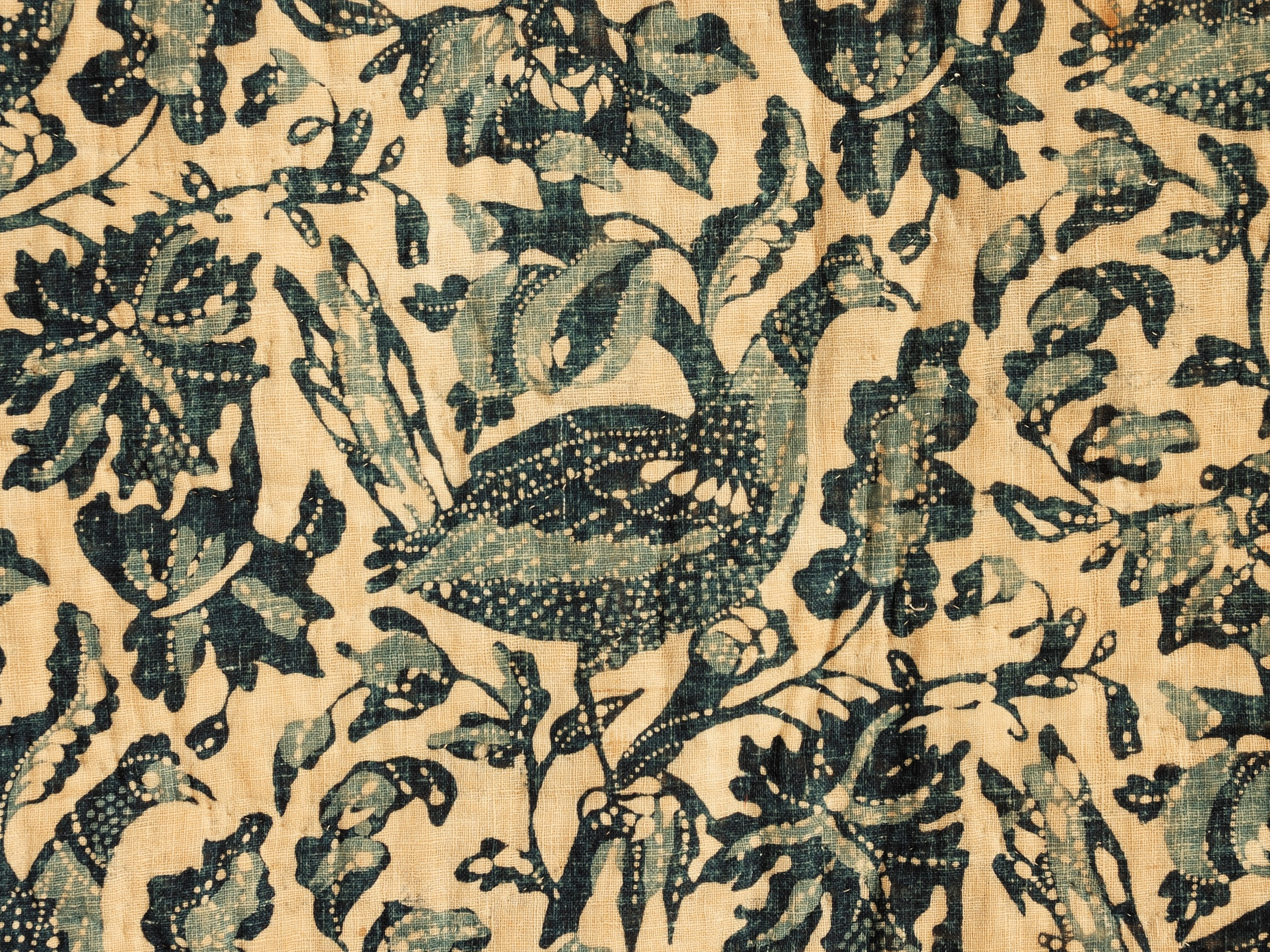
Blue Resist Quilt (detail)
Maker unknown. Linen, c. 1790.
77 x 69 ½ inches.
This wholecloth quilt dating from the late eighteenth century is a remarkable survival. The blue dye is indigo and the overall design is achieved by a technique called resist printing. Fabrics with a blue pattern on a white background are far less common than white designs on an indigo background. Both would have been very labor-intensive to produce and therefore very costly. Found mostly in America, they are generally referred to as “American blue resist,” but textile historians have yet to discover exactly where and how these extraordinary fabrics were made. The quilt was the gift of Frances Martin. It had been purchased from the estate of Benjamin Dwight Latham of Orient Point. Many Latham families still live in Orient.
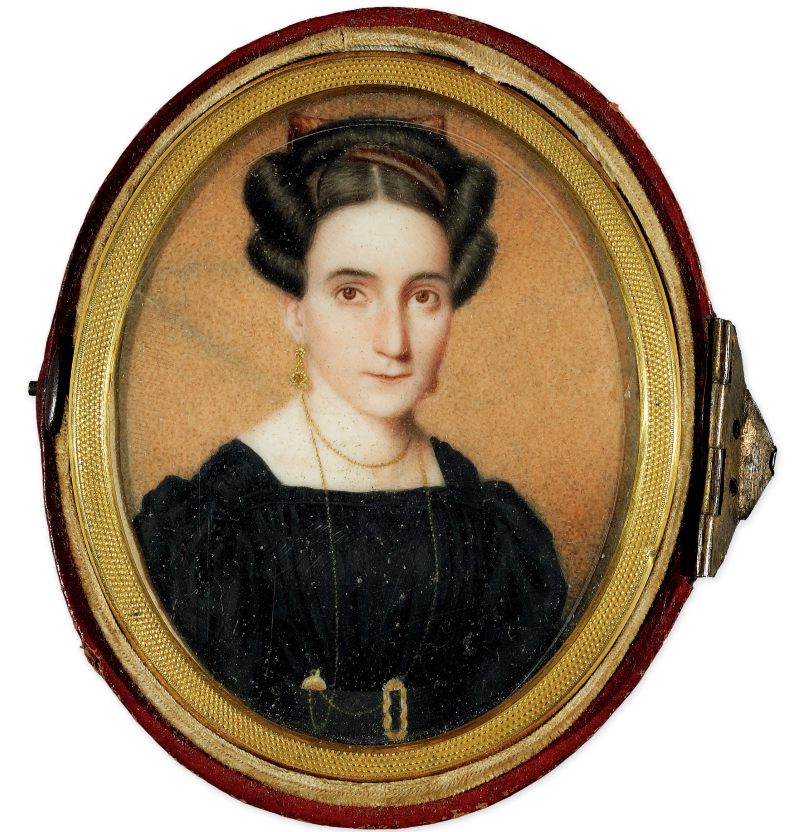
Miniature Portrait of Cleora Griffin
John Wood Dodge. Watercolor on ivory, c. 1830. 3 3/8 x 2 ¾ inches.
Cleora Griffin, daughter of Augustus and Lucretia Griffin, was born in 1799. She was married in 1830 to James McNeil, who died at age eighty-three on February 14, 1864. Cleora died the very next day. By their very nature, portrait miniatures are personal and intimate, often tokens of love or affection. This was painted about the time of Cleora’s marriage to McNeil and was very likely a gift from one to the other. The artist, John Wood Dodge, was born in New York in 1807, studied at the National Academy of Design, and was exhibiting there at the age of twenty-two. By the 1830s he was one of the most prominent painters of miniatures in New York. This miniature is a gift of Fred Griffin Prince.
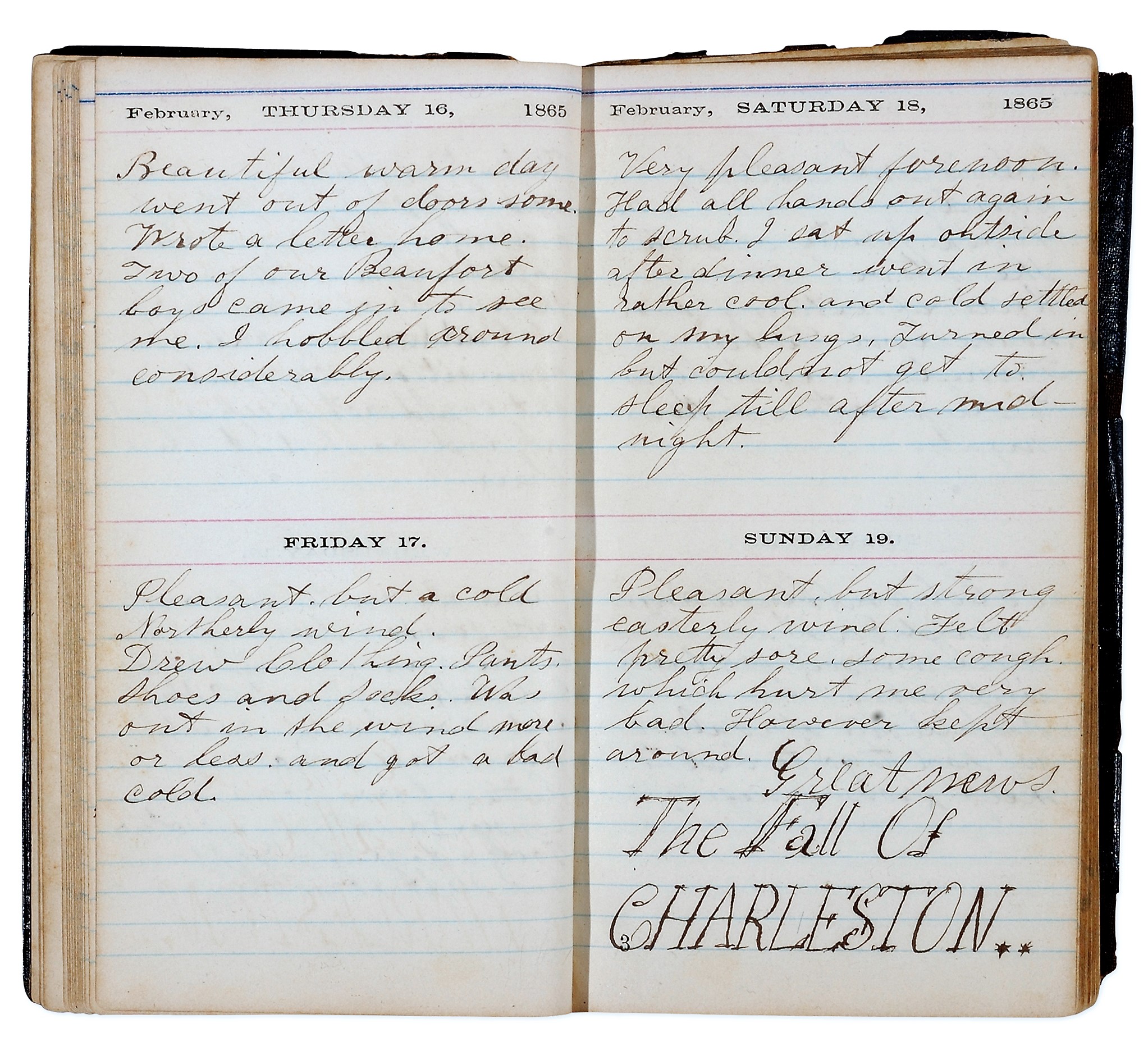
Civil War Diary
John Henry Young. 1865. 5 ¼ x 6 ½ inches.
John Henry Young was born in Orient in 1840 and enlisted, as did so many young men from Orient and East Marion, as a Union soldier in the Civil War, serving with the 127th U.S. Volunteers. Although injured in the war, he survived and returned to Orient, where he became a farmer, living until 1921. His diaries were given to the OHS by Beverly Lomas. This volume for the year 1865 begins on January 1: “The new year which today begins its accustomed round finds me severely wounded in the Field-Hospital at Deveaux Neck. Cousin George [Latham] lies by my side also severely wounded.” His cousin died on January 12. On January 30: “A lot of Sherman’s men came to the Hospital.” Then, on February 19, a momentous event, written in large letters: “Great news. The Fall Of CHARLESTON..”
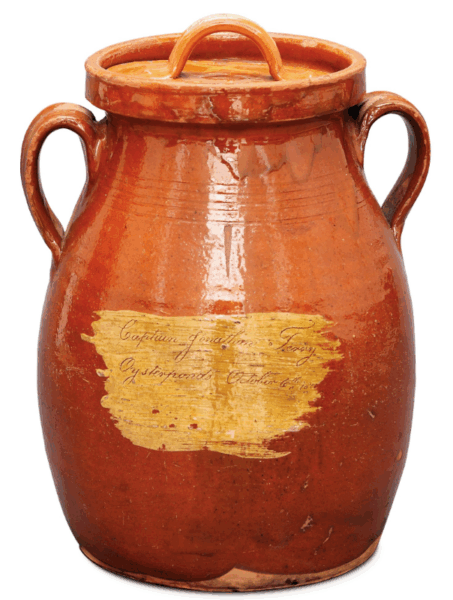
Double-Handled Pot with Lid
Maker unknown. Earthenware, 1800.
13 ¼ x 9 inches.
This important example of American earthenware pottery is inscribed: Captain Jonathan Terry / Oysterponds / October 6th 1800. It was likely made for Captain Terry on Eastern Long Island or in Connecticut and is very similar to one in the Winterthur Museum and Country Estate in Delaware, which has an inscribed date – extraordinarily – just one day later than the Oysterponds Pot. The Terry family has been on the North Fork since the earliest European settlement in the 17th century. This pot was given by Marian Edwards and her brother Irving Latham. Their mother was a Terry.








